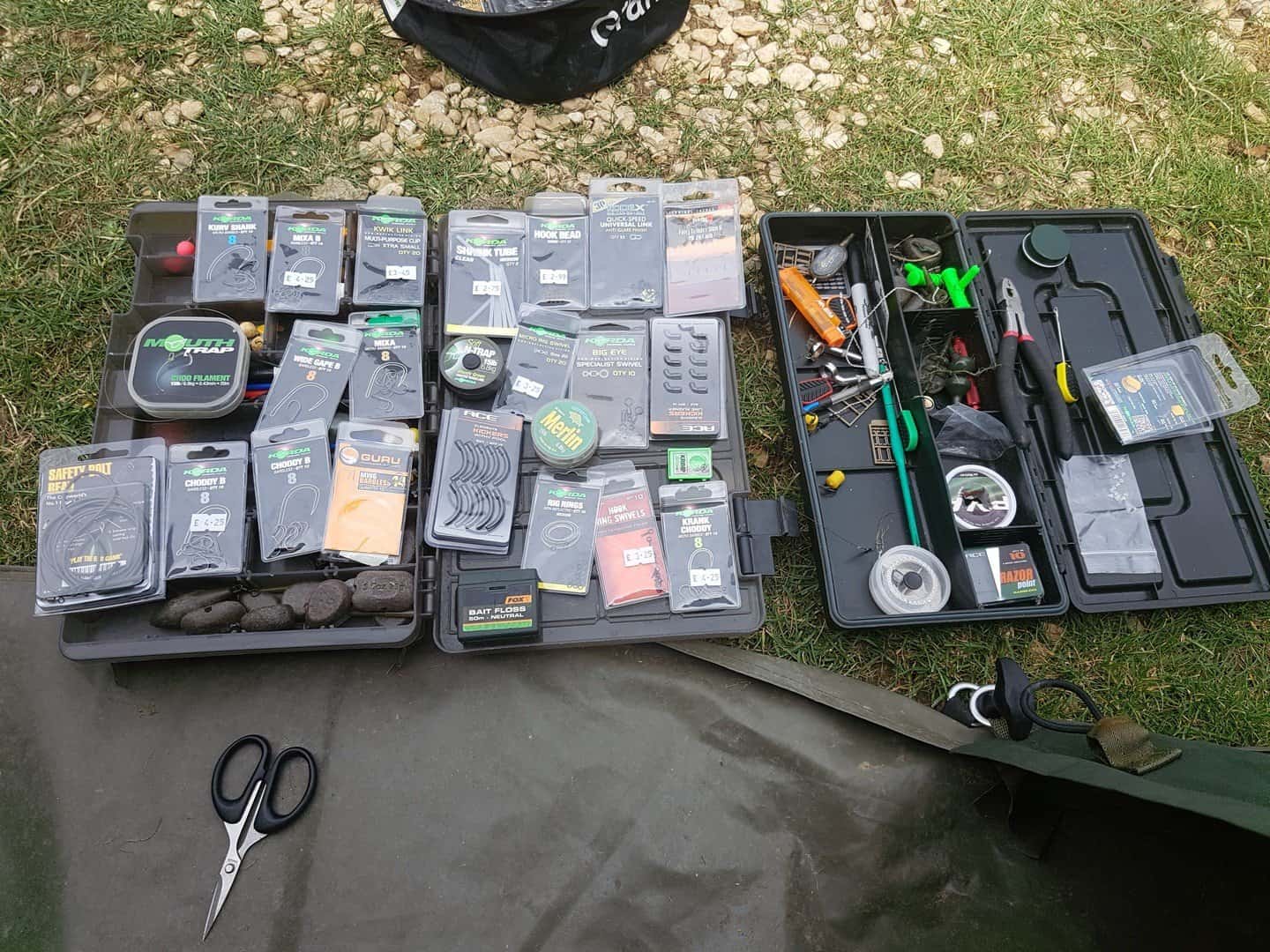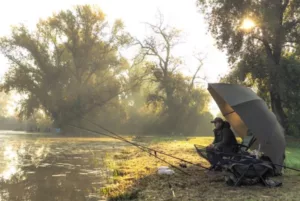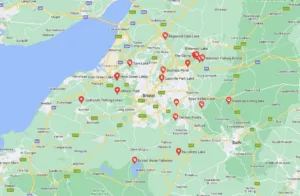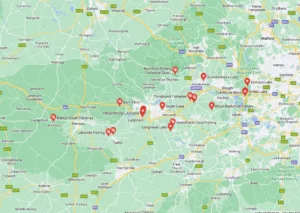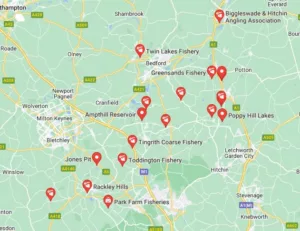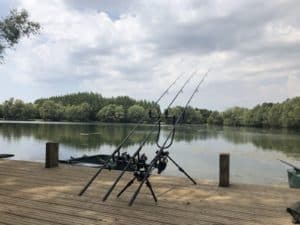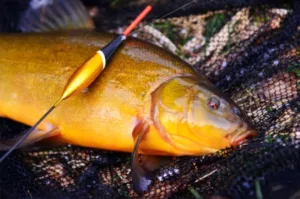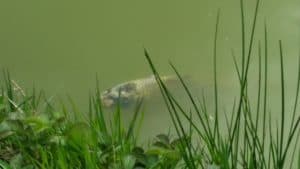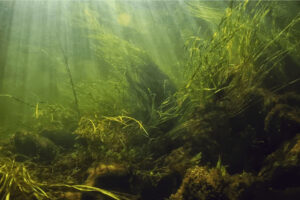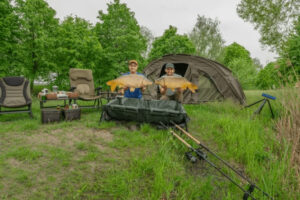As a beginner carp angler, there is one aspect of carp fishing you must learn. Rigs…
Until you learn how to use rigs properly and when to use each rig, you will be seriously limiting your ability to catch carp.
You need to learn:-
- How to tie carp rigs as a beginner
- What carp rig to use for each situation
- What size hooks to use and why
- Carp hook patterns and when to use them
So, let’s cover these in this carp rigs for beginners series.
Different Methods of Catching Carp
Firstly, there are a few different methods of catching carp;-
- Surface Fishing – Fishing to the top of the water
- Zig Rig Fishing – Fishing in the middle layers of the water
- Ledger Fishing – Fishing on or close to the bottom
Ledger Fishing for Beginners
Let’s focus on ledger fishing since ledger fishing has lots of different types of rigs.
But firstly, let us understand why knowing how to tie carp fishing rigs is important.
All lakes are different when it comes to what the lake bed is made up of. And because ledger fishing involves fishing with your rigs on the lake bed, the rigs need to follow the contours of the lake bed, above weed, sit above silt or chod, and keep the hook clear of debris on the lake bed.
Different rigs are meant for certain types of lake beds.
You have the option of buying ready-tied rigs, like these rigs on Amazon, but over time you will end up spending lots of money because ready-tied rigs cost more than tying your own.
There are times when you need to shorten the rig slightly or use a slightly bigger hook, being able to tie your own rigs will give you this ability.
How Does a Hair Rig Work?
Carp, in particular, feed in a very particular manner compared to other fish. Carp are bottom feeders, which means they eat food mostly from the lake bed. They do this by sucking in the bait, chewing it, then blowing the debris and non-food items out through their gills.
Because of this, the carp bait is tied to the hair of the rig and secured with a boilie stopper, and when the carp suck the bait in, the hook follows into their mouth, hopefully catching hold of their lip in the process.
The carp will then swim away with the hook in their mouth, and as they are swimming away, the lead will come into play and pull the hook deeper into the lip, making it difficult for them to spit out the hook.
How Do You Tie a Hair Rig?
There are three major components to a simple hair rig.
- Hook link
- Hook
- Bait
The hook link is tied to the hook with a knotless knot, the bait is attached to the hair section of the rig, and the hook link is attached to the main line.
Make sure you have some Razor Sharp scissors when tying rigs (click here to see mine).
What is a Carp Safety Rig?
With ledger fishing, we use a lead weight to pull the hook into the lip of the carp. If the main line was to break and your rig was left attached to the fish, the lead could get snagged into branches for example, which would mean the fish could be tethered and eventually die.
With this in mind, all anglers need to use safety rigs, and by this, we mean that the lead should be able to come free if the fish become snagged.
To make the rig safe for the carp should it break, for most of the standard hair rigs, we use a rig component called a lead clip.
The lead clip allows the lead to stay on during the cast, but pull off with a little bit of force and become free of the rig should it become stuck.
With other rigs such as the chod rig or helicopter rig, the lead is attached to the main line and two beads stop the rig from moving up the line. Then if there is any pressure toward the beads, the beads will slide up the line and become free of the lead.
What is a PVA Bag Rig
A PVA Bag rig is quite simply a short rig that is made specifically to fit into a PVA bag. They can be bought pre-tied on Amazon here – click the link to go to Amazon.
Further Reading: How to Fish With PVA – A Complete Guide
Further Reading: Tips on How To Use PVA Bags and PVA Mesh
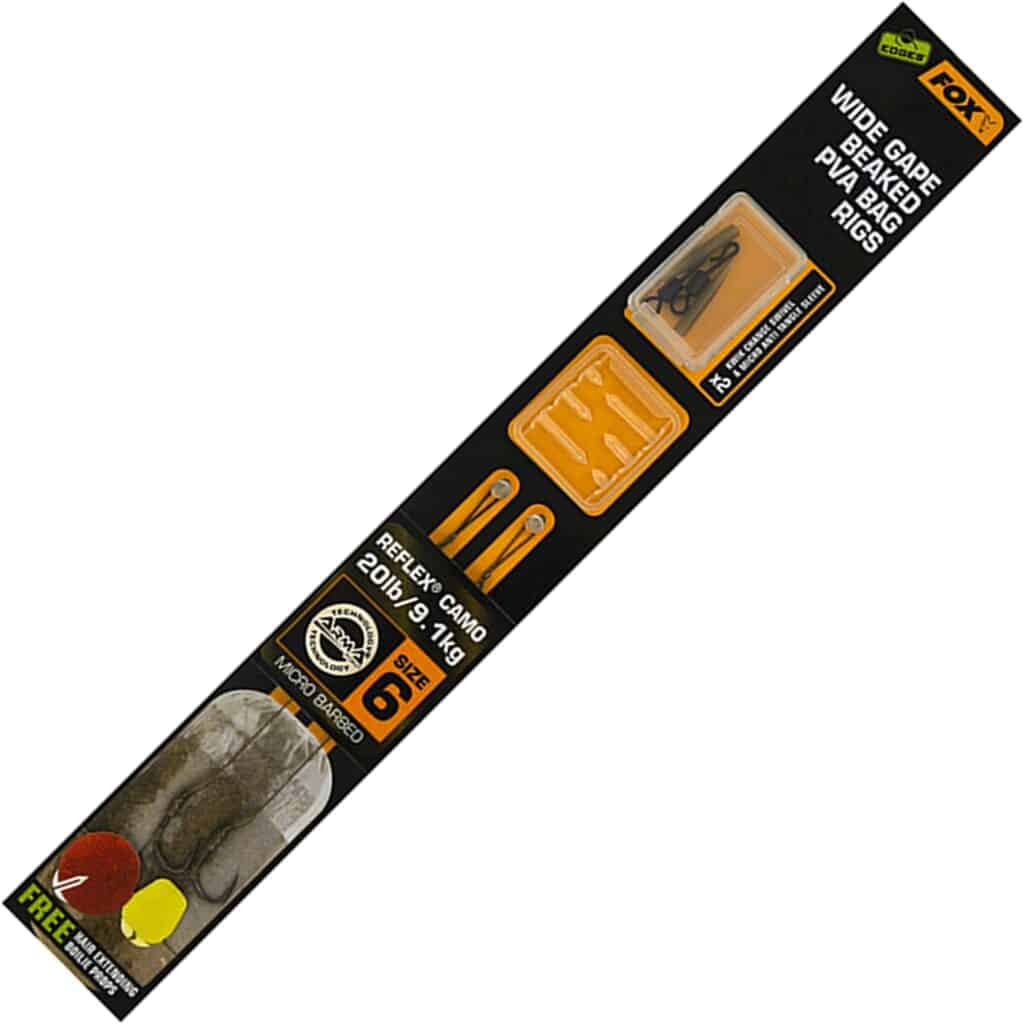
What is The Best Size Hook for Carp?
Test difference sizes would be my answer to this question.
But for single-figure carp, a hook sized between 14 and 10 would be the most suitable.
For you who are targeting double-figure carp, a hook sized between 10 and 6 would be the average size.
Anything over that, for example, if you are fishing a lake that has lots of 20lb+ fish, you could try hooks between a size 6, to a size 4.
How to Make a Hair Rig Step By Step
How Long Should a Carp Rig Be?
Typically, standard hair rigs are between 4-inches and to 8-inches, but the true answer is, that you need to adapt your rig to suit the situation that you are fishing in.
If you are fishing in the margin of a lake targeting individual fish, you will likely choose to fish a short 4-inch rig as you want the carp to hit the lead as soon as they turn away from the bait.
Whereas, if you are fishing out in the open water with a wide spread of bait, it’s likely that the fish will be moving around a lot, picking up boilies that are spread out, but you will also have lake contours to contend with, so you will most likely be better off fishing with an 8-inch rig.
What Size Weights Should I Use For Carp Fishing?
To get an idea as to what sized lead weights you should be using for ledger fishing, you need to understand the theory behind it.
The lead is used to cast your rig into the lake. It is also to set the hook. But there is a downside to using lead, the fish use it to their advantage by shaking their heads, and using the lead to pull the hook out of their mouth.
Some anglers use 4-oz leads all of the time, for every aspect of fishing, but I will only use a 4-oz lead if I am long-distance casting.
Instead, I use a lead that is heavy enough to get me to my spot when casting out but still as light as possible.
Typically I will start at a 2-oz lead in the margin, and then increase the weight when having to cast at a distance.
Further Reading: Fishing Leads I Like to Use
What is the Best Lead Clip System to Use
There are lots of lead clips on the market, all from different manufacturers.
Although most of the do the exact same job as the others. What is the best lead clip system to use and why?
What makes a lead clip stand out from the others?
The purpose of a lead clip is to safely release the lead should a fish become snagged. It is also to lose the lead if you are fishing a lake tha has lots of weed, losing the lead will help bring the fish into the upper layers and stop the fish from burying their heads into the weed.
The best lead clip system is one that can blend into the lake bed, and have features that will allow the lead to eject when the fish is hooked. The lead clip system I use most often is Fox edges camo lead clip (click to see it on Amazon), as it blends nicely into most lake beds.
What Is Rig Tubing Used For
Rig tubing is made from plastic and is fish-friendly, which means it can protect the scales from getting underneath the fishing line. It also helps prevent tangles while casting.
The use of tubing is used as a means of reducing tangles. The higher diameter helps prevent the hook link from wrapping around the lower diameter of the line. Ideally, the length of the tubing should be a foot or so longer than the length of the hook link.
The lower-diameter tubing is commonly used in lead clip arrangements. It can also be utilized in helicopter-style lead setups, where the main line is sheathed in order to prevent the lead from rubbing against the mono while playing hooked carp. This alternative arrangement is useful if your preferred venue has a leader ban.
Besides being able to reduce the tangles, the use of tubing also provides another advantage: It prevents the line from getting into contact with the flanks of the fish. This is because it can minimize the chance that the line will lift a scale.
Modern rig tubing is made from a combination of materials that are both supple and sink like a stone. This ensures that the line is not exposed to snags and provides a smooth surface for fishing.
When to use a Helicopter Rig
The use of a helicopter rig is a great way to cast a hook bait in a lake that is weedy or silty. It can prevent the hook from sinking into the water and give you the perfect presentation.
For me, the purpose of helicopter rigs is to provide a certain type of presentation that’s ideal for certain situations. A good fisherman will use these setups in the right way, so it’s important to understand why they’re being used.
For me, the main types of lead setups are either an inline system or a helicopter system. While a helicopter doesn’t need to be complicated to set up, it’s very easy to master once you’re comfortable with it. The advantages of a helicopter rig are that it rarely gets tangled.
The main advantage of a helicopter rig is that it allows you to move the hook around the lead, which provides freedom of movement on the fly. It also sits over a variety of lake beds. One of the most important factors that you can consider when it comes to keeping the hook link clean is to adjust the top bead on the leader.
Depending on the type of weed or light silt that you’re dealing with, you can move the leader up or down a couple of inches. For instance, if you’re dealing with light silt, you can move the leader up a couple of inches.
Best Rig for Pop-Ups
Probably the most popular pop-up rig is the hinged stiff. It’s a popular choice among big-fish enthusiasts. The design of the hinged stiff rig is not subtle. It’s often presented a couple of inches off the bottom.
One of the most important factors that you should consider when it comes to using a pop-up rig is its buoyant nature. If you don’t use corkball pop-ups, other air-ball styles are also good options. Just make sure that you are casting them in the edge to check if they are sitting how you expect.
The Ronnie Rig
I have used the Ronnie rig in various situations, such as in weed, where there are large particles and a spread of boilies. It has worked well in these situations.
I have not tried using small seed, but I am sure that it will work with a shorter hooklink and a tiny bit of additional material molded into the shrink tube to stop it from moving around due to the water displacement.
Since I have been using different substrates, such as silt and gravel, I have modified the lead arrangement and the length of the hook to suit the different conditions. This decision affects the type of hooklink material that I will use. For instance, if the lake is relatively clean and I want to use a helicopter rig, then I will use a mono hooklink or a tricklink.
The 360 Rig
The 360 rig is a great choice when it comes to casting pop-up rigs. Its long and curved hook allows it to move quickly in the mouth of the fish. This type of rig can also be used with different types of hooklink.
This type of rig can be used on a variety of lakebeds, but not in weed. Just make sure that you choose the right hooklink type for the water conditions. If you are fishing on clean gravel, a stiff hooklink is ideal, while a supple braid is better suited for silt.
A buoyant pop-up is also needed when it comes to casting this presentation. One of the most popular types of pop-up rigs is the corkball style.
The Withy Pool Rig
Withy Pool rig has a long and curved section of the shrink tubing below the hook helps the pop-up rig and the bait get set up aggressively and quickly.
The goal of this presentation is to be fished with a buoyant pop-up, which can be either a cork dust or a corkball pop-up. Although this type of presentation will work just as well with a standard air-ball pop-up, make sure that you use the right type of bait.
A curve-shanked hook, a long piece of shrink tubing, a medium rig ring, a bait floss, a coated braid hooklink, and a split shot are some of the components that will be used for this presentation.
How to Tie Pop-Up Rigs
What is the Best Type of Hook for Carp Fishing
There are various types of hooks that can be used for different types of fishing. These are all designed to work well in different situations.
Further reading: Fishing Hooks I Use When Carp Fishing
The choice of hooks depends on your personal preference and confidence in the type of fishing you are doing.
The wide gape is a classic short-shank style of hook that is ideal for most types of fishing. It provides excellent hook holds and is very versatile, making it one of the most popular patterns on the market. This hook can also be used for both pop-up and bottom fishing. You can additionally extend the length of this hook by using a shrink tube or line aligner.
The long-shanked hook is a popular style of hook that has fallen out of favor in recent years. It is designed to improve the hook’s ability to catch hold in the mouth of a fish. This type of hook is also ideal for blowback rigs. It provides plenty of length for the bait to move up and down using a rig ring.
One of the most popular hook patterns on the market right now is the curved-shanked hook. This type of hook is very hard to remove, making it ideal for most types of fishing. The popularity of this type of hook can be attributed to the Ronnie rig, which is a key component of pop-up presentations. This type of hook provides an excellent pop-up presentation, and it is sitting at an ideal angle for a fish to approach it.
The out-turned-eye design of the chod hook is very similar to that of the wide gape. This is because it is designed to make this type of hook ideal for use with stiff materials such as the Korda Boom and Amnesia. If you are planning on using these types of materials with other patterns, you might want to consider using a different hook pattern. Chod hooks can be very deadly when used in certain situations, such as when dealing with stiff-hinged rigs or using a combination of these.
I have made a lot of mistakes during my fishing sessions and don’t want you to make the same mistakes. I’ve learned the hard way over 20 years of fishing most weekends, testing, tweaking, and testing again and now want to help you excel with your carp fishing.
If you need any help, you can reach me at Fishing Again’s Facebook page
Last Updated on February 4, 2024 by Shane

